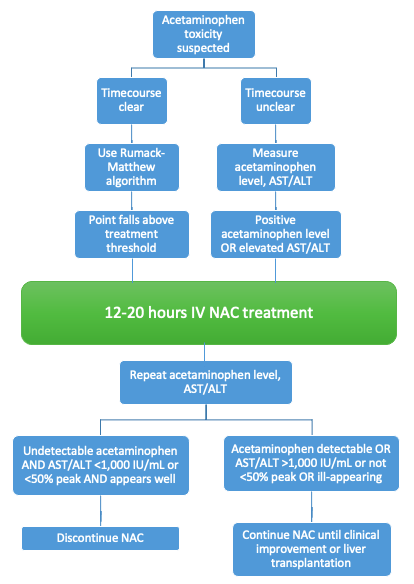Getting the Knack of NAC
Background on acetaminophen toxicity
Acetaminophen toxicity accounts for 46% of acute liver failure cases in the US. Many overdoses are single ingestions; in adults, this is frequently intentional in a suicide attempt. However, nearly half are chronic ingestions with the aim of pain relief. In cases where a timepoint for a single ingestion is known, the Rumack-Matthew nomogram can be used, which plots hours from ingestion against acetaminophen level to predict who is at risk for hepatic damage. Those whose point falls above and to the right of the line could benefit from N-acetylcysteine (NAC) treatment. The original nomogram published in 1975 is below.
Figure 1. Nomogram of hepatic toxicity by hours after single ingestion versus acetaminophen level (mcg/mL).

Image taken from Rumack and Matthew. Acetaminophen poisoning and toxicity. Pediatrics. 1975.
How does NAC work?
NAC provides cysteine, a precursor to glutathione that is involved in metabolism of the toxic N-acetyl-p-benzoquinone imine (NAPQI) molecule. It has additional beneficial effects of scavenging free radicals and promoting oxygen delivery and blood flow to the liver and other organs.
Who could benefit from NAC treatment?
The strongest evidence for the use of NAC is for prevention, rather than treatment, of hepatic injury. Thus, rapid administration of NAC after ingestion provides the most benefit, ideally within 8 hours. However, some retrospective studies have studied NAC administration after the onset of hepatic injury, which also showed substantial improvements in mortality. Thus, in addition to those identified by the nomogram, most experts also recommend acetylcysteine in cases where there is a high risk for hepatic injury, or in those who already have evidence of hepatic injury. As in our patient case, if the timing of ingestion is unclear, it is recommended to administer NAC if the acetaminophen concentration is detectable or if there are transaminase abnormalities.
The authors of a 2018 Cochrane review concluded that, “Acetylcysteine should be given to people at risk of toxicity including people presenting with liver failure.” However, the optimal dose and duration in these situations is not clear, as randomized clinical trials are lacking. The authors found that a 12-hour protocol of IV NAC had fewer adverse effects than a 20-hour protocol, although there was insufficient power to determine if the shorter duration had similar efficacy. Among those given IV, slower infusion rates were associated with fewer adverse events than standard infusion rates.
A practical approach is to treat for 12-20 hours (the elimination half-life for acetaminophen is 2-4 hours), at which point repeat acetaminophen level and transaminases are drawn. If the acetaminophen is undetectable, the transaminases are <1,000 IU/L or <50% of their peak value, and the patient is otherwise well (i.e., mental status, renal function), NAC can be discontinued. If those conditions are not met, NAC can be continued until the patient’s clinical status improves or they undergo liver transplantation.
Figure 2. Treatment algorithm for acetaminophen toxicity.

Image adapted from Dart and Rumack. Patient-tailored acetylcysteine administration. Ann Emerg Med. 2007.
Among those without hepatic failure (i.e., encephalopathy or coagulopathy), oral acetylcysteine can be considered, with a 140 mg/kg loading dose followed by 70 mg/kg doses given every four hours for 72 hours, or 17 additional doses. Shorter courses have also been trialed. Tolerance may be limited by nausea or vomiting, in which case the IV formulation is preferred.
How does repeated supratherapeutic ingestion differ?
In cases of chronic ingestion, the Rumack-Matthew nomogram cannot be used. In these cases, NAC is recommended if the acetaminophen level is >20 mcg/mL or there is evidence of liver injury.
Those at highest risk for liver injury from chronic ingestion are those taking higher doses of acetaminophen, or with predisposing conditions such as alcohol use. In one study, 63% of patients in the accidental overdose group had comorbid alcohol abuse. Unfortunately, the chronic ingestion group had more severe liver necrosis, hepatic coma, and death as compared to patients in the single ingestion group.
What else could be causing her liver injury?
This patient has several potential etiologies for her severe acute liver injury. Trimethoprim-sulfamethoxazole, a sulfa-containing antibiotic, can cause a hypersensitivity reaction in the liver, typically with an associated rash within several weeks of starting the medication. This medication has been implicated as among the top 5-10 causes of drug-induced fulminant liver failure. Fortunately, most cases self-resolve.
The patient was also taking several weight loss supplements, including green tea extract. Although drinking green tea can lower ALT levels, high concentrations of green tea extract have been associated with hepatotoxicity. The pattern of injury is typically hepatocellular and resolves after discontinuation of the supplement, although fatal cases have been reported. In addition to their direct toxic effects, many herbal supplements can inhibit glucuronidation of acetaminophen, an important step in detoxification.
Although we typically associate NAC with acetaminophen toxicity, a prospective trial showed that NAC improved transplant-free survival in other etiologies of acute liver failure, most significantly in cases of DILI or HBV with coma grades I-II. It is postulated this benefit is due to NAC’s effects on tissue perfusion and oxygenation.
We explore drug-induced liver injury in more depth in an earlier post.
What is the prognosis of acetaminophen-induced liver injury?
A prospective study of 22 tertiary care centers reported a 71% 3-week survival in patients with acetaminophen-induced acute liver failure. King’s College criteria were developed in 1989 to identify variables associated with a poor outcome, which included acidosis (arterial pH <7.30), prolonged PT (>100 sec, or INR >6.5), elevated creatinine (>3.4 mg/dL), and hepatic encephalopathy. High lactate and/or phosphate levels may be earlier predictors of hepatotoxicity and aid in prognosis.
